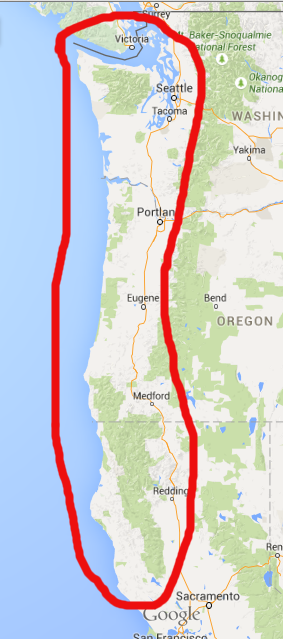The Pacific Northwest is Doomed

If you have friends who live in the U.S. states of Washington or Oregon, you’ve probably seen this tremendous piece from The New Yorkeron social media this week, likely accompanied by words of dread and nightmare fuel, or at least a long string of disconcerted emojis.
To offer a very basic summary, a massive earthquake is expected to develop in the next hundred years out of the Cascadia subduction zone, which stretches from Vancouver Island, Canada, to Mendocino, California. The tectonic plate beneath the region would effectively collapse, triggering a 45-foot tsunami that would make an absolute mess of the coastline. Everyone who lives within the red zone below — and plenty of people outside of it — would be in deep, deep fertilizer.

It’s a long read, but I recommend carving out the 15-20 minutes it’ll take to run through thearticle. Its author, Kathryn Schulz, has an incredible talent for conveying complicated subjects (like the many endeavors of paleoseismology) in digestible form. She also spares no grisly account of the horrors that would play out should “the big one” occur within our lifetime. Casualty estimates are at roughly 40,000 people with 13,000 dead. That might be a slight exaggeration, but then again not many people expected 16,000 people to die during the 2011 quake and tsunami in Japan.
The most disturbing part of the piece is Schulz’s relentless account of just how unready the region is to sustain such a disaster. There is not yet a working emergency earthquake system in place. Efforts to move schools away from sea level are batted away by pound-foolish taxpayers. Thousands of structures — including police stations, fire stations, and hospitals — are not built to survive a 9.0 tremor. That’s not a very comforting thought: fire engines unable to come to your rescue because they’re buried beneath the fire house.
In the following excerpt, Schulz details the risk of a big quake and explains why so many structures are not built to withstand it:
“The science is robust, and one of the chief scientists behind it is Chris Goldfinger. Thanks to work done by him and his colleagues, we now know that the odds of the big Cascadia earthquake happening in the next 50 years are roughly one in three. The odds of the very big one are roughly one in 10. Even those numbers do not fully reflect the danger — or, more to the point, how unprepared the Pacific Northwest is to face it. The truly worrisome figures in this story are these: Thirty years ago, no one knew that the Cascadia subduction zone had ever produced a major earthquake. Forty-five years ago, no one even knew it existed.”
For those reading this in the Pacific Northwest who currently need a new change of pants, I’d recommend hopping over to this useful Reddit AMA featuring local seismologists offering tips and advice for how to prepare your family to survive. For example, they recommend having supplies that could keep everyone alive for seven to 10 days as you weather loss of power, impassible roads, and potential injury. For those who live against the coast, where a tsunami could follow a quake by as little as half an hour, the best advice is a little more stark and simple: Run. Run as fast as you can.
One aspect of the article that leaves me a little steamed is the lack of urgency of the populace and its leaders to reinforce the region. It’s the sort of inertia that Neil deGrasse Tyson says makes him ashamed of humans — the inane ability to hear and see existential risk and then do nothing, either out of selfish greed (“Why should my tax money go toward earthquake-proofing a school? I don’t even HAVE any kids!”) or foolish denial (“Maybe if I just ignore it, nothing will happen!”).
My gut tells me that Schulz may have embellished the destruction a little bit, or at least offered a worst-case scenario rather than a likely scenario, but it seems fairly clear that her goal in writing the piece was to scare people into action. Heck, why not prepare for the worst-case scenario?
It’ll be interesting to see how the local, state, and federal government’s react to the article. The status quo for disaster preparedness and infrastructure repairs has for a long time been “eh, better sorry than safe, because safe costs money.”
Let’s hope that perspective shifts before Portland and Seattle are devoured by a seismic beast.
Read more at The New Yorker & Oregon Live & Reddit.
Photo credit: Stock photo ©peterscode / Getty





